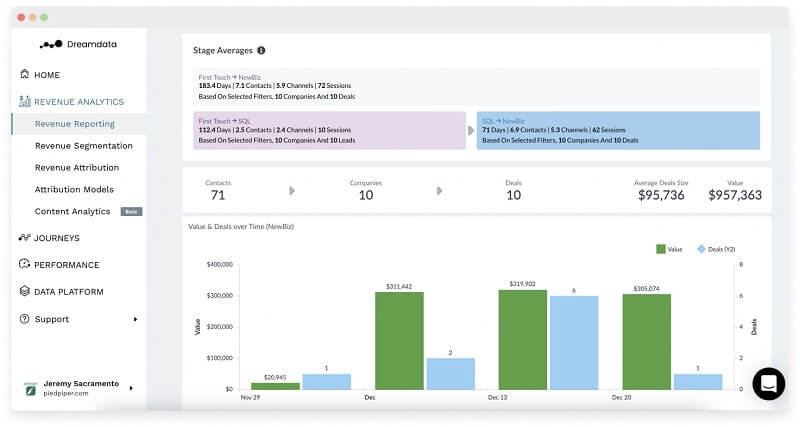
Hello guys, today in this article, we will discuss using decision-driven revenue analytics to maximize b2b ROI. So keep reading.
Revenue analytics is a process that uses data to guide decisions about pricing, product mix, and other factors that impact revenue. The goal of this process is to optimize revenue by making data-driven decisions that maximize value for both the company and the customer. While traditional financial analysis focuses on past performance, revenue analytics looks to the future, using data to identify and predict trends. This approach can help companies make more informed decisions about pricing, product development, and marketing.
In today’s competitive business environment, those who can make data-driven decisions are well-positioned to succeed. Decision-driven revenue analytics is an essential tool for any company looking to optimize its revenue.
Also, you can check: Top 6 B2B Marketing Trends In 2023.
How Can You Use Revenue Analytics To Increase Your B2B Marketing ROI?
If you want to increase your B2B marketing ROI, you need to start using decision-driven revenue analytics. Using revenue analytics and marketing attribution tool will allow you to see which marketing activities are driving the most valuable leads and customers. With this information, you can allocate your marketing budget more effectively and focus on the strategies that are giving you the best return.

In addition, decision-driven revenue analytics can help you improve your sales pipeline by identifying which leads are most likely to convert. This tool ensures that your marketing efforts always drive maximum value for your business.
How Does Revenue Analytics Work?
Revenue analytics is the process of tracking and analyzing a company’s revenue in order to improve performance and make better decisions. This can be done by tracking different channels of revenue, such as sales, marketing, and customer support. Revenue analytics can help identify trends and areas for improvement by taking data from each of these channels and compiling it into a comprehensive report. This data can then be used to make informed decisions about where to focus resources in order to increase revenue.
What are some of the key factors that you need to consider when implementing a revenue analytics strategy for your business?
There are a few key factors to consider when implementing a revenue analytics strategy for your business.
1. You need to identify your key performance indicators (KPIs).
These are the metrics that you’ll use to track and measure progress against your revenue goals.
2. You need to establish a data collection and tracking system.
This will help you collect the necessary data points to populate your revenue analytics reports.
3. It would help if you chose the right software solution for your needs.
There are various revenue analytics platforms on the market, so it’s important to select one that meets your business’s specific needs. By following these steps, you can set your business up for success with revenue analytics.
How can you get started with revenue analytics today, even if you don’t have any prior experience with it?
Revenue analytics involves using data to understand how revenue is generated, what factors influence it, and what strategies can be used to increase revenue. While revenue analytics can be complex, there are a few simple steps that any business can take to get started.
1. Identify Your Revenue Streams.
Revenue can come from many different sources, such as product sales, services, subscriptions, or advertising. Once you know where your revenue is coming from, you can start to track it. This data can be collected manually or through software applications.
2. Analyze Your Revenue Data.
This step involves looking for trends and patterns in your revenue data. Consider factors such as seasonality, customer behaviour, or marketing campaigns. By understanding these patterns, you can start to optimize strategies to increase revenue.
3. Develop Optimization Strategies.
Once you have identified patterns in your data, you can develop strategies to improve your revenue. This may involve changing your pricing structure, targeting new customer segments, or launching new marketing campaigns. By implementing these strategies, you can start to see an increase in your revenue.
Revenue analytics is a powerful tool for businesses of all sizes. By taking these simple steps, you can start using revenue analytics today to improve your bottom line.
Are there any other tips or advice that you would recommend for businesses looking to improve their ROI through data-driven decision-making?
There are a number of ways that businesses can improve their ROI through data-driven decision-making.
B2B businesses should also look to customer segmentation data to better understand their target audience. By understanding who their customers are and what they want, businesses can more effectively market to them and drive sales.
It’s always important to track key metrics such as conversion rates and customer lifetime value. By constantly monitoring these numbers, businesses can ensure that they are making the most of every sale and generating long-term value for their customers.
Conclusion
So, what is decision-driven revenue analytics? Simply put, it’s a data-driven approach to business decisions that helps you maximize your return on investment (ROI). By taking into account all of the data available to you — including customer data, sales and marketing data, and financial data — you can make better decisions about where to allocate your resources in order to see the biggest impact. And the benefits of using decision-driven revenue analytics are clear for businesses of all sizes.
If you’re looking for a way to improve your ROI through data-driven decision-making, then decision-driven revenue analytics is definitely worth considering. Ready to get started?
Author’s Bio:
Jenn Pereira is a digital marketing strategist with extensive experience in SaaS growth hacking. She aids businesses by providing them with imaginative ideas and strategies that produce tangible results. She has also helped numerous companies achieve 400,000 monthly visits or more through her inventive and resourceful marketing methods.

